
Dear Friend,
Political and social upheaval is affecting not just the US, but much of the world. Add in ZIRP and NIRP, almost-flatlining GDP growth, and global debt of $152 trillion, and you have a combustible mixture.
It’s a mixture that’s creating the most difficult investing environment of the last 100 years. And the 60/40 portfolio? That’s kaput.
Now, getting through this history-making period will undoubtedly be tough...but we will get through it.
I’ll say that once more with feeling.
We will get through it.
We face grave problems, but there is no doubt in my mind that you and I will come out the other side better than ever.
The future looks sunny—and as we travel there, we’ll encounter great, extraordinary opportunities.
I’m proud to say I have one of those opportunities for you today.
More on that in a moment...
2017—a Brave New World for Investors
But first—to navigate the future, we need to look at the now. The global economic chain has several weak links, each looking a little frayed around the edges.
A word of warning—what comes next is gloomy. Running through these weak links is like going through a tunnel, but I promise there is light at the end of it (both in this letter and in reality).
With that disclaimer rolled out, let’s go.
1. The United States—Big Changes Afoot
Early November 9, the US delivered a seismic shock to half of its population and the rest of the world by electing Donald Trump. But now that the Trump genie is out of the bottle, we need to get on with taking care of business...
And that business is that winter is still coming. There are political “third rail” issues that straddle the pre- and post-Trump worlds, and they’re not going gently into the night.
a. Income Shortage
Real wages have barely increased in the last four decades. Median income is up just 3% in the last 16 years, while the median new home price has almost doubled. People all over our great country are hurting badly. And post-2008 monetary policy has been cruel to savers and income investors.
b. Healthcare Crisis
While Americans struggle to find income, healthcare costs are shooting up. The US is getting older and grayer, so it’s going to take something remarkable to reduce those costs in the coming years. And the Affordable Care Act is in a death spiral, with the midlevel benchmark plan set to increase its premium by an average of 25%.
c. Entitlement Tsunami
In 2019, entitlement and defense spending and interest will consume all the tax revenue collected by the government. By 2023, entitlement spending and interest will be consuming almost all tax revenue... and our defense spending will be on credit. We’ll be on the horns of a dilemma, forced to choose between trillions of dollars of spending cuts, tax increases... or even-more-out-of-control debt.
d. Recession Time
We’re adding around $2 trillion a year to the national debt. But that is going to get worse. I believe we will see another recession not too far down the road. And even if the US government only loses the tax revenue it lost last time, the deficit will explode to $1.3 trillion. That much debt constrains growth. It constrains nominal GDP, which hampers wage growth and the labor participation rate. And that will lead to increased deprivation.
It’s still too early to evaluate what President Trump will do. We don’t know today whether he will build a wall... or foment trade wars... or make American manufacturing great again... or solve the Obamacare problem... or any number of other things.
We won’t know tomorrow, either.
But that doesn’t mean this period of extraordinary uncertainty will last forever, and it doesn’t mean we can’t thrive in it. It means that as investors, it’s time for us to saddle up and ride a successful path through it.
2.Europe—Will the EU Be Mothballed?
The European Union sandcastle is in danger of being washed away. Anti-EU right-wing populism—embodied by Brexit and buoyed by Trump’s victory—is sweeping across Europe. The Russia-funded National Front in France is having a field day. France, Germany, and others go to the polls next year. Italy votes next month on a change to its constitution, and whispers of “Italexit” have already begun.
Europe has other problems, too. For starters, add in severe problems in its banking sector and an average debt-to-GDP ratio of 90% across the euro area.
The ripple effect of Europe’s problems can whip right across the Atlantic. Equity markets react strongly to European uncertainty, a stronger dollar spells bad news for our exports, and US companies and banks are exposed in Europe.
3. Russia—a Wounded Bear Lashing Out
In recent years, US-Russian relations have been in freefall. Today, we have a love-in between the president-elect and Vladimir Putin, who said that Russia “is ready to restore the full-fledged relations with the US.”
It’s a remarkable turnaround, even if it’s only rhetoric, and puts Russia front and center of the world stage.
That’s what Putin wanted. Russia’s economy is in trouble, and its people are feeling the pain of two years of recession. Geopolitical victories (including Russia’s role in Syria) help pacify the people at home.
It’s too early to call what happens next. Given the choice of predicting the next decade or the next few months, give me the decade any time. What could improving relations mean for the US defense industry? If Trump lifts sanctions on Russia, will the ruble rise? Could Russia start pumping out more oil? Could Russian equities become attractive to contrarian investors?
4. China—a Fraying Silk Road
The markets are watching nervously as China attempts the notoriously tricky move from a manufacturing Goliath to a consumer-driven economy—while grappling with a slowing economy and debt that’s hitting 250% of GDP.
Now, Donald Trump wants to slap a tariff on some imported Chinese goods if China doesn’t open up its markets. The government-controlled Global Times warned that Beijing would respond “tit-for-tat” and that Trump would be condemned for his “ignorance and incompetence.”
Them’s fighting words. China’s “tit-for-tat” approach would bump up the cost of almost everything you buy at Walmart... and automation makes it doubtful that manufacturing jobs would return to the US anyway. (As an aside, Apple is now considering making iPhones in the US. Why not? Robots can work anywhere, and it would allow Apple to cut out the shipping and the middleman.)
US exports of goods and services to China totaled $113 billion in 2015. Tariffs from both sides would drag on US, Chinese, and possibly global growth.
Nobody wins in a trade war. I hope cooler heads prevail, but it does produce a huge risk that we have to pay attention to.
5. Emerging Markets—Where’s the Exit?
Emerging markets also are holding an enormous debt burden. Last year, the Bank of International Settlements announced that dollar borrowing by non-US entities shot up 50% from 2008, to $9.6 trillion.
EM countries have trillions of dollar-denominated debt that they’re going to have to pay back with their own currencies. If the world’s major central banks embark on currency wars, emerging market economies will be coming to that gunfight with a butter knife.
Adding to the drama is the increased geopolitical risk in emerging markets. Just look at our neighbor, Mexico. The peso, which “wins” the award of the worst-performing currency this year, fell to record lows in the wake of Trump’s election. Sure, it recovered slightly after Trump rowed back on some campaign pledges, but we can expect to see more roller-coaster action.
The Inevitable Question: What Will the Fed Do?
What will the Fed do in this period of global uncertainty? I can tell you what I think the Fed will do—get it wrong.
It will fight tooth and nail against what it believes is the devil itself: deflation. Negative interest rates, more quantitative easing—you name it, they will do it.
The Inevitable Question Part 2: In a world drowning in debt, besieged with political turmoil, and hobbled by governments seemingly hell-bent on wealth destruction, what should we do?
We have to think the unthinkable, and we have to expect the unexpected.
Global growth is the only thing we’re left with as investors. That’s why I think diversifying among asset classes in the next 10 years is going be futile. We have to diversify among the strategies we use to trade the asset classes.
And that’s where Mauldin Economics has a hell of a starting lineup.
The Light at the End of the Tunnel
I promised at the start of the letter that there would be light in this gloom—thanks for sticking with me.
As I was reflecting over Thanksgiving, one of the things I gave thanks for was the Mauldin Economics analysts. My partners and I have spent a lot of time building a team you want in the trenches with you during these volatile years.

Patrick Watson, my protégé and senior economic analyst, who sees around corners better than anyone I know... Robert Ross, wunderkind and creator of our proprietary stock selection system... Patrick Cox, whose 30 years at the coalface of investigating tech breakthroughs translate into a portfolio that hasn’t lost yet... Kevin Brekke, veteran assessor of the world’s best sources for wealth protection... and former Wall Street trader Jared Dillian, a staunchly contrarian analyst with a phenomenal ability to lasso market psychology.
When we’re all in a room, I never feel like the smartest person in it.
Taken as a whole, the team is a key reason I’m positive about the world to come. Their combined outlooks... the ideas that spark in them daily... and their PDQ (pretty damn quick) ability to adjust to changing market circumstances and lay out a roadmap for a successful future, all confirm to me that exciting, bright times lie ahead.
I’m truly thankful for that. I’m also thankful for you, my readers, without a doubt, one of the smartest, most passionate, most vocal communities around.
And so I got thinking about how I, and my team of trusted analysts, can best serve you through the volatile times ahead. I want you not just to “get by,” but to thrive.
That’s why today, I’m pleased to open up Mauldin Economics VIP for a short time.
Mauldin Economics: Your Team for the Future
Our mission at Mauldin Economics has always been simple—to help you chart a more successful investment course and be among the very first to know about looming risks and upcoming opportunities.
And we aim to do that by getting the bluest blue-ribbon research publications into your hands in the most cost-effective and efficient way possible.
That’s how Mauldin Economics VIP was born. VIP doesn’t need to be dressed up with bells and whistles to look pretty, so here it is in a nutshell: You get six premium services, at a discount of up to 74%, for up to two years.
You’ll have the entire team working on your behalf to war-game the coming months of market volatility and uncertainty, helping you find that global growth and protect your portfolio from the downside.
And as the community is limited in size, members also get VIP treatment throughout the year, including early notification of events such as the Strategic Investment Conference (or as I like to call it, the greatest economic gathering on earth), as well as other offers and discounts the team arranges for you.
Let’s take a run through it. If you decide to become a Mauldin Economics VIP today, you’ll get subscriptions to:
NEW Macro Growth & Income Alert
with Patrick Watson and Robert Ross (Value: $1,995)
Grow your portfolio month by month with stress-tested stocks... and make it work harder with conservative options strategies.
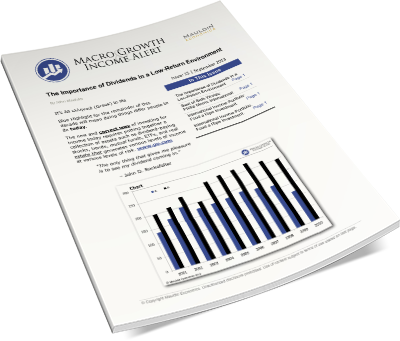
Macro Growth & Income Alert, from Senior Economic Analyst Patrick Watson and Senior Equity Analyst Robert Ross, takes the kind of macroeconomic insights you read in Thoughts from the Frontline and converts them into a portfolio of solid stocks.
I‘ve worked closely with Patrick for three decades, and together we knuckle down on Thoughts from the Frontline every week. The man can spot a macro trend at 1,000 paces.
Every month, Patrick crunches through data and research to uncover a promising macro trend. Using Robert’s Equity Evaluation System (EES), which evaluates individual stocks by measuring more than 100 factors, the team finds stable companies with the most growth potential.
And to add even more firepower, they use a low-risk, minimal-effort options strategy to generate income ($2,117 since April).
So far, Patrick and Robert have uncovered a corner of the stock market that’s almost guaranteed to keep thriving... an undervalued energy company... a gold-standard, any-weather stock positioned to thrive in a new age of deglobalization... and more. I can’t tell you how excited I am about this new service and what it can help subscribers achieve.
Over My Shoulder
with John Mauldin (Value: $179)
Be the best-informed person in the room with me as your personal research assistant.
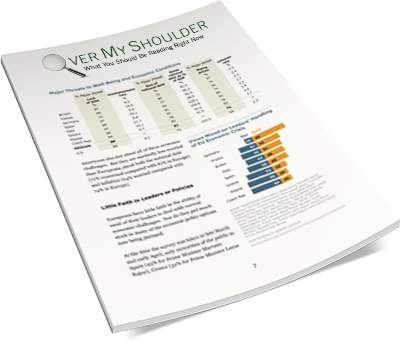
Your portfolio’s health depends on you being well-informed—but keeping up with the latest, finest economic research and analysis is a big task.
That’s the thinking behind my private readers’ club, Over My Shoulder. I vet the reams of world-class, expensive research that crosses my desk, and when I find something I think deserves your attention, I send it directly to you, usually accompanied by a quick note. As subscriber Anthony G. says: “[It’s] like a small door at the end of a wide moat. Mauldin sorts through a ton of reports to send the reader only the best.”
I recently sent my readers a Gavekal Research report on the rising odds of a US recession, Avalon Advisors’ Sam Rines on why the Fed needs to make a policy error, and post-election analysis from Grant Williams of Things That Make You Go Hmmm... fame.
That’s just a slice. It’s my pleasure to share with you the work of some of economics’ most brilliant minds.
Rational Bear
with Kevin Brekke (Value: $2,495)
Get downside protection for the rest of your portfolio with our premium bearish service.
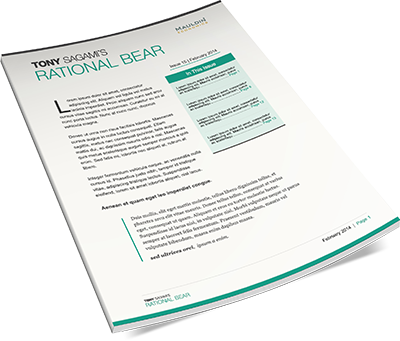
We’re currently riding the second-longest bull market ever—2,842 days (but who’s counting).
When the inevitable market correction comes, you want to be tucked up safely with Rational Bear.
Rational Bear’s purpose is two pronged. First, it adds a layer of protection against a general market decline or financial crisis by uncovering securities that don’t track the broader markets.
Additionally, it aims to profit from the decline of market, sector, or individual security by identifying stocks that are ripe for shorting.
With Rational Bear, you have by your side an “investment committee” of superstar analysts: Mauldin Economics Managing Editor Kevin Brekke, Jared Dillian (Street Freak, The Daily Dirtnap), and Robert Ross (Macro Growth & Income Alert).
Now, clearly, shorting stocks can be risky and is definitely not for beginners. But if you’re a sophisticated investor, this premium service can give you smarter-than-the-average-bear downside protection for the rest of your VIP portfolio.
Aside from monthly Rational Bear issues, you’ll receive timely email alerts when fast action is required, complete with point-by-point trading instructions from Kevin. As we saddle up for the wild ride ahead, I’m glad we have Kevin and his team at the Rational Bear helm.
Street Freak
with Jared Dillian (Value: $299)
Learn intuitive macro investing from a master of market psychology.
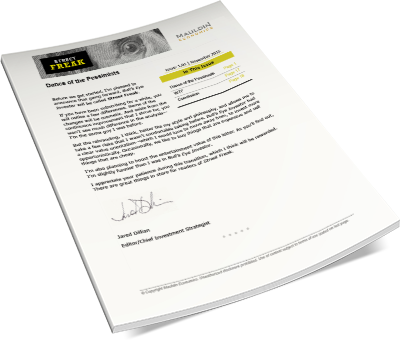
In all my decades reading, writing, and publishing investment newsletters, I have never seen anything quite like Street Freak. Jared Dillian is a former Wall Street trader, acclaimed author (I recommend you check out his book, Street Freak: Money and Madness at Lehman Brothers), and a truly maverick financial writer.
Apart from being a lot of fun to read thanks to Jared’s irreverent style, Street Freak offers a master class in market psychology and a staunchly contrarian view.
Every month, you’ll get Jared's stock and fund recommendations, as well as portfolio updates, trend analysis, and insights into the market. Together, they make up what I think is one of the sharpest takes on macro investing that you can find anywhere today.
By the way, nearly all of the trades Jared recommends to his Street Freak readers are based on long-term trends he invests in himself. And his trader’s instincts have been paying off: His highly diversified portfolio is up 16.2% year to date (as of November 21, 2016). Even Brexit didn’t break Street Freak’s successful streak.
Yield Shark
with Patrick Watson (Value: $199)
Hunt down yield in today’s low interest rate oceans, while being prepared for any market weather conditions.
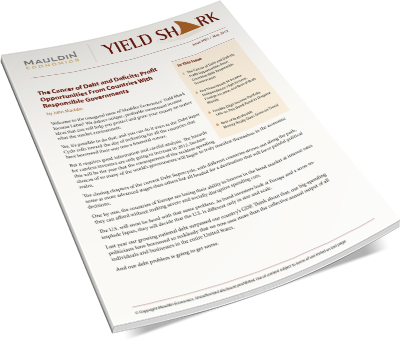
Savers and retirees have suffered for almost a decade of low-interest, no-interest, or even negative-interest rate central bank policies. The old rules no longer work in this strange new ocean.
If formerly safe havens like CDs and money market funds aren’t enough anymore, what are yield-seeking investors supposed to do?
Yield Shark, our flagship income advisory service, is here to help. Written by Patrick Watson, Yield Shark scours the seas for high-yield income opportunities. And one of its great strengths is its ability to change its course on a dime.
Here’s a behind-the-scenes look at the direction Patrick is taking Yield Shark in over the next year or more, as we deal with a Trump presidency and market volatility.
-
Diversify, Diversify, Diversify: Yield Shark is swimming strongly toward funds and ETFS in order to spread exposure.
-
Buy Strategic Bonds: Patrick will continue hunting down corporate and high-yield bonds, which are less vulnerable to higher interest rates...unlike long-term Treasury bonds.
-
Reduce Stock Exposure: Yield Shark will continue to carefully choose individual stocks with both attractive income and capital appreciation opportunity, but will reduce the portfolio’s overall single-company exposure.
This three-step approach will help you earn sustainable current income and protect your capital from big losses, ensuring Yield Shark will steer you into safer waters in the months ahead.
Transformational Technology Alert
with Patrick Cox (Value: $1,495)
Discover the companies shaping tomorrow with a portfolio that’s never closed a losing position.
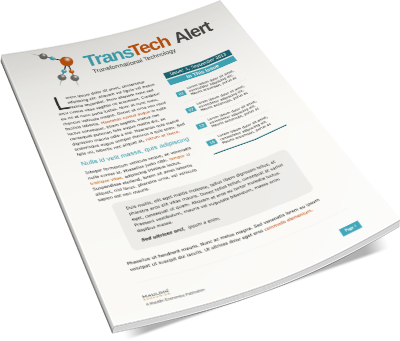
As you are probably aware, I am very excited about new discoveries in the fascinating field of bioscience and life extension. Whenever I need an update on the latest breakthroughs, I turn to my good friend Patrick Cox for his expert opinion. Patrick has researched paradigm-changing biotechnologies for over a decade, and if he doesn’t know about something in this area, it’s probably not worth knowing about.
Patrick’s advisory, Transformational Technology Alert, focuses on the small-cap biotech companies that could revolutionize modern medicine. From innovative cancer treatments that could make the old “slash and burn” methods obsolete, to ways to slow down and even reverse biological aging... Patrick keeps track of the most promising research that is out there today.
Every month, you’ll receive a full report on a new biotech opportunity from Patrick and his team, plus weekly updates and as-needed trade alerts when breaking news requires fast action. Since its launch in September 2013, the Transformational Technology Alert team has only sold winning stocks—a testament to Patrick’s “take profits when possible” approach.
Beat the Decade of Disruption
Six Ways from Sunday
The six premium services that are part of a Mauldin Economics VIP membership are our solution to the demanding investment environment we’re in, and the unpredictable one that lies ahead.
The risk versus reward of a one-way strategy is now much higher than most people think—diversifying strategies with Mauldin VIP will help get you ahead of the game.
Now, if you need another good reason for subscribing, it’s a simple question of doing the math.
If you add up what it would cost you to subscribe to each of these services for one year, the total amount comes to $6,662—and I believe they’re worth every penny.
A one-year VIP membership, on the other hand, will get you the same services for just $2,475—which adds up to a savings of $4,187, or 63%.
Click here to become a Mauldin Economics VIP now
Before I sign off, let me share a few important details of your VIP membership:
-
If you already subscribe to any Mauldin Economics publications, you’ll pay even less—we will credit the remaining months of your subscriptions to your VIP membership fee.
-
Your VIP membership is completely risk-free for 30 days. You can take that time to settle in—and if you decide that a VIP membership is not for you, simply cancel within those 30 days for a full refund or request to go back to your previous subscriptions, and we’ll be happy to help you.
-
As always, the window for becoming a VIP member is narrow. We will close this offer on December 13 and won’t reopen it for at least six months.
And now, that really is it for today. I’m truly charged up about the opportunities that lie ahead—and I hope you join us so we can benefit from this Decade of Disruption together.
Your looking forward to an exciting future together analyst,

John Mauldin
Chairman
![]()
P.S. Through December 13, we’re also offering a two-year VIP membership with an even bigger discount. The fee is $3,450 for two years, which gives you a pretty monumental discount of $9,874 (or 74%). Click here to find out more.
Copyright © 2016 Mauldin Economics